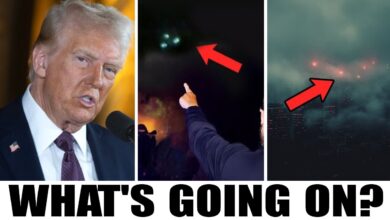Something Horrible Just Happened At CERN That No One Can Explain

Descubrimientos y experimentos en el Gran Colisionador de Hadrones (LHC) del CERN, que realiza investigaciones profundas sobre la física y el universo. Aquí hay un resumen detallado de los puntos principales:
1. **Introducción al LHC y al CERN**:
– El Gran Colisionador de Hadrones (LHC) es una de las máquinas más grandes y complejas jamás creadas por el hombre, cuya tarea es descubrir los misterios del universo. Uno de los descubrimientos notables del LHC es el bosón de Higgs, también conocido como la “partícula de Dios”. Este es uno de los mayores logros de la física nuclear, ya que ayuda a aclarar cómo las partículas elementales adquieren masa.
2. **Descubrimiento inesperado en el LHC**:
– Aunque el LHC ha producido muchos descubrimientos importantes, experimentos recientes también han mostrado resultados inesperados. Uno de ellos es la desviación de quarks extraños, cuya desintegración no es la que predice el modelo estándar de física nuclear. Esto abre la posibilidad de la existencia de aspectos no descubiertos de la física.
3. **Los neutrinos y la teoría de las dimensiones extra**:
– Se ha descubierto que los neutrinos, partículas elementales que tienen poca interacción con la materia, pueden moverse más rápido que la luz, lo que va en contra de la teoría de la relatividad de Einstein. Aunque este resultado fue posteriormente explicado por un error técnico, creó una ola de especulaciones sobre la existencia de dimensiones adicionales, dimensiones más allá de las tres que conocemos.
4. **Experimentos sobre dimensiones extra y microagujeros negros**:
– Los experimentos en el LHC también exploran la posibilidad de la existencia de dimensiones adicionales que son invisibles a simple vista. En teoría, estas dimensiones podrían tener un efecto sobre las partículas elementales, cambiando su comportamiento, como cambios de órbita o de energía. Además, el LHC también puede crear microagujeros negros en condiciones extremadamente extremas, lo que puede ayudar a los científicos a comprender mejor la gravedad y la estructura del espacio-tiempo.
5. **La conexión entre los experimentos y las teorías físicas modernas**:
– Estos experimentos no sólo ponen a prueba las teorías existentes sino que también amplían nuevos descubrimientos. Una de las teorías importantes en esta investigación es la teoría de la supersimetría, que establece que cada partícula elemental tiene una contraparte con propiedades diferentes. Esta teoría está asociada con dimensiones adicionales y puede ayudar a resolver muchos problemas que no han sido explicados por la teoría física moderna.
6. **El futuro y las preguntas sin respuesta**:
– Los experimentos en el LHC aún no han mostrado evidencia concreta de dimensiones adicionales o pequeños agujeros negros, pero las observaciones y los datos existentes están planteando grandes preguntas sobre la naturaleza del universo. Estos hallazgos podrían cambiar completamente la forma en que entendemos el universo y los teoremas físicos fundamentales.
CERN is at the forefront of exploring theoretical frameworks like string theory and loop quantum gravity, aiming to answer fundamental questions about the nature of the universe. **String theory** proposes that the basic particles of nature are not point-like, but instead, tiny vibrating strings. These vibrations may lead to the existence of new particles, known as **string excitations or string states**, which could provide insights into extra dimensions, a crucial aspect of string theory. Discovering these particles could validate string theory and help explain how additional dimensions beyond the observable ones influence our reality.
**Loop quantum gravity**, another leading theory being explored at CERN, seeks to reconcile general relativity with quantum mechanics by suggesting that space-time itself is quantized—made of discrete, indivisible units rather than being a continuous fabric. This theory could reshape our understanding of dimensions and the very fabric of space-time, offering a new perspective on how gravity works at quantum scales.
CERN’s ongoing experiments are specifically designed to test the predictions of these theories. For instance, if string theory is valid, CERN’s research could reveal particles or phenomena not predicted by the standard model of particle physics. These discoveries might include particles tied to string vibrations, or behaviors of known particles that differ due to the influence of extra dimensions, fundamentally altering our understanding of how the universe operates.
Moreover, CERN is delving into the **many-worlds interpretation (MWI)** of quantum mechanics, which adds another layer of complexity to these theories. According to MWI, every quantum measurement results in the universe splitting into multiple realities, each representing a different outcome of the quantum event. Researchers at CERN are investigating whether these parallel universes could provide additional insights into quantum mechanics and how they relate to extra dimensions. For example, MWI suggests that the act of observing a particle causes it to exist in multiple states across different parallel universes, each with its own version of reality.
This introduces the possibility that **extra dimensions** could manifest as distinct branches of parallel universes. These universes might have their own sets of physical laws, which could explain why physical constants, like the speed of light, vary across different contexts. Additionally, MWI could offer a new understanding of **wave-particle duality**—the concept that particles like electrons exist simultaneously in multiple states, potentially interacting across different dimensions.
Furthermore, quantum entanglement, a phenomenon where particles become instantaneously connected regardless of distance, might occur across these parallel universes. This adds another layer of complexity to the potential interactions between particles in different realities, making the study of MWI crucial to understanding the nature of quantum mechanics and extra dimensions.
As CERN continues its groundbreaking work, **quantum computing** and **simulation technologies** are providing new ways to simulate quantum systems on a massive scale. These technologies could help test MWI predictions by allowing scientists to explore how particles behave in multiple parallel universes, providing experimental data to confirm or challenge these theories.
Despite its promise, the **MWI** is still a developing theory and presents significant challenges for experimental validation. One of the major hurdles is designing experiments that can conclusively distinguish MWI from other interpretations of quantum mechanics. However, its potential implications for the dimensional hypothesis are significant, highlighting the importance of exploring diverse theoretical frameworks to advance our understanding of the universe.
CERN’s technological advancements have also led to innovations outside of fundamental physics. For example, **PET scans**, which are widely used for cancer diagnosis, were developed using technology originally designed for particle physics experiments. Similarly, improvements in particle detection have contributed to advancements in **medical imaging** and **radiation therapy**.
Beyond these practical applications, CERN’s commitment to **open scientific research** has fostered widespread collaboration across various fields, from **material science** to **artificial intelligence**. The laboratory remains a hub for innovation and discovery, where theoretical ideas are tested and transformed into groundbreaking technologies.
CERN’s work on string theory, loop quantum gravity, MWI, and other cutting-edge areas promises to deepen our understanding of the **universe**. As it continues to explore **extra dimensions**, **quantum mechanics**, and the nature of reality itself, it has the potential to reshape our view of the cosmos and offer new insights into the fundamental principles governing existence.








